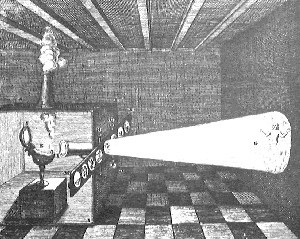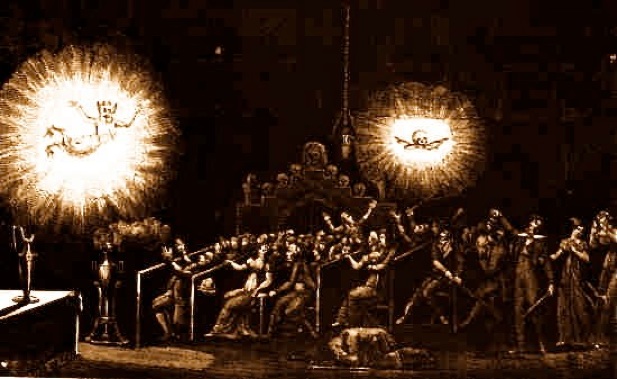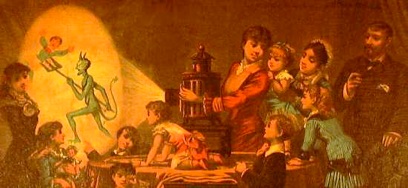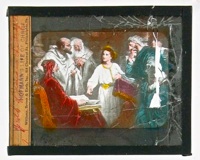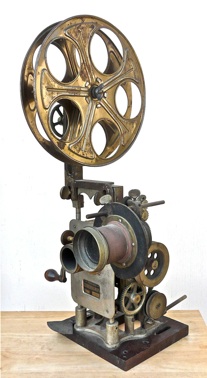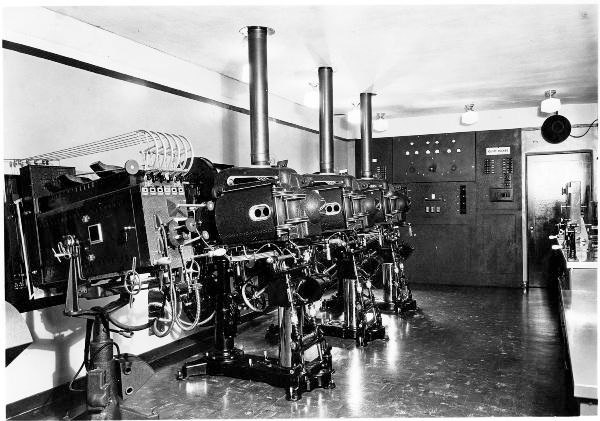Beginning with the first shadow-show put on by a clever neanderthal using only his hands, a campfire and the side of his cave, humans have been entertained by images projected on a wall. That art remained primitive for a long time. It wasn’t until 1420 that picture projection made its first great leap forward with the invention of a crude machine to project images onto a wall. Since the contraption didn’t have glass lenses, the results were generally blurry at best.
Entertainment seekers waited another two hundred years for projection to take its next big step. In the mid 1600‘s, a book was published which described the possibility of projection using convex lenses. The concept caused great interest among Europe’s scientific community. Netherlander Christian Huygens, astronomer, mathematician and physicist, famous for his wave theory of light and building the first accurate clock, is frequently credited as the inventor of modern projection thanks to his being one of those who developed a practical projector just a few years after the book came out. Huygens’ machine is well documented in letters from his father, who more than once begged Huygens to send him a “magyc lantern” so he could “frighten his friends with it.”
The first recorded production of lanterns for sale followed almost immediately. In 1666, diarist Samuel Pepys became an early customer, buying a magic lantern fabricated by English telescope maker John Reeves. In his diary, Pepys wrote about using it “with pictures on glass, to make strange things appear on a wall; very pretty.”
Two years later, English scientist Robert Hooke described a lantern’s effect as “delightful” and pointed out that spectators unfamiliar with optics who saw “the various apparitions and disappear-ances, the motions, changes and actions, that may this way be presented, would readily believe them super-natural and miraculous.”
Magic lanterns were an immediate hit with the public. From the 1700s onward, hundreds of people were involved in manufacturing lanterns, lenses, slides and accessories. Their inventiveness made it possible to project ever-more-sophisticated
slides to larger and larger audiences. A science lab novelty became mass entertainment. Paris of the 1790’s became enthralled by “phantasmagoria” shows, during which a variety of horrific images of demons and monsters were projected in totally dark theaters by projectors hidden from view behind translucent screens. Smoke was added to give the illusion of movement. One Parisian showmen put a lantern on wheels so he could move images from side to side and front-to-back so the images would seem to travel, appearing larger or smaller, like a modern zoom lens.
As with most technology, lanterns kept improving, becoming more compact and getting less expensive. During the entire 1800’s traveling showmen roamed rural America putting on entertainment, travel lectures, kiddy shows and religious stories from the Bible. By using multiple synchronized projectors, the illusion of movement became ever more realistic. By the end of the 19th century, lantern slide production and projection had become big business in Europe and America. In 1890, 28 firms were making lanterns and slides in London alone. Slides were produced in a variety of formats for home projection, but 4” x 3.25” became the professional standard.
In 1895 Paris the Lumiere brothers gave their first public demonstration of “cinematographe” (motion pictures) and a huge new pastime was born. Movies were immediately more popular than slide shows, but unlike most technological advances where the new quickly drives the old from the marketplace, slide projection remained part of theater entertainment until the 1950s.
One of the hundreds of movie theaters that used professional size glass slides was the Waikiki Theater in Honolulu, Hawaii. Built in 1936, a full 40 years after the Lumiere’s world-changing demonstration, the Waikiki's movie film projection booth was spacious and home to state-of-the-art motion picture equipment. One of the earliest professional movie projectors, from 1904 by Powers. This and its separate light source are part of the NCHM collection on display in our entrance area. It had no take-up reel; the film spooled off the reel, through the shutter then fell through a hole into a wastebasket. A hand-crank on the other side of the reel was used to rewind.
The new theater wasn’t equipped with just any-old slide projector, but a Brenograph, a super magic lantern that not only projected announcements and song slides for the organ interludes, but an endless variety of scenic effects by means of multiple lenses and moving slides with intricate fades and dissolves.
Effects that could be created using Brenographs and glass slides were listed in a slide catalog of that period as Aurora Borealis, Babbling Brook, Blizzard, Descending Clouds (for imaginary ascension trip), Flying Angels, Flying Birds, Flying Butterflies, Fire and Smoke, Flames, Lightning, Fast-moving Dark Storm Clouds, Slow-moving Fleecy Clouds, Moving River, Ocean Waves, Rain, Sand Storm, Snow, Volcano in Eruption (with flowing lava and rain of fire and ashes), Waterfall, Waving American Flag, Flying Fairies, Flying Airplanes, Falling Roses, Twinkling Stars, Rainbow, and Rising Bubbles. So equipped, the operator had at his finger tips the power to conjure up disaster, holocaust, or a plague of butterflies.
The Waikiki wasn’t alone. I can remember slides and intermission sing-alongs in Los Angeles area movie theaters I attended in the 1940s and early 1950s. Most theaters gave up projecting lantern slide sing-alongs around the time that technicolor, 3-D, Cinemascope and television became part of the entertainment landscape. Coming attraction slides were replaced with film clips made and supplied by the movie studios. Popcorn, candy and soda ads were produced by professional agencies. Both were supplied on standard 35mm theatrical film.
A few theaters, including the Waikiki still played live music into the 1990s, but “a few” is the operative phrase, as slides and sing-alongs were little more than a novelty by the end of the 20th century. But ads we still have with us. Alas. Sometimes the things you want to change, don’t.
A small selection of slides follows, including four cigar ads, two coming attractions, two sing-alongs and four theater-announcements. Settle into your seats, grab a handful of popcorn, and enjoy.


